1993 PONTIAC GRAND-AM light
[x] Cancel search: lightPage 128 of 306
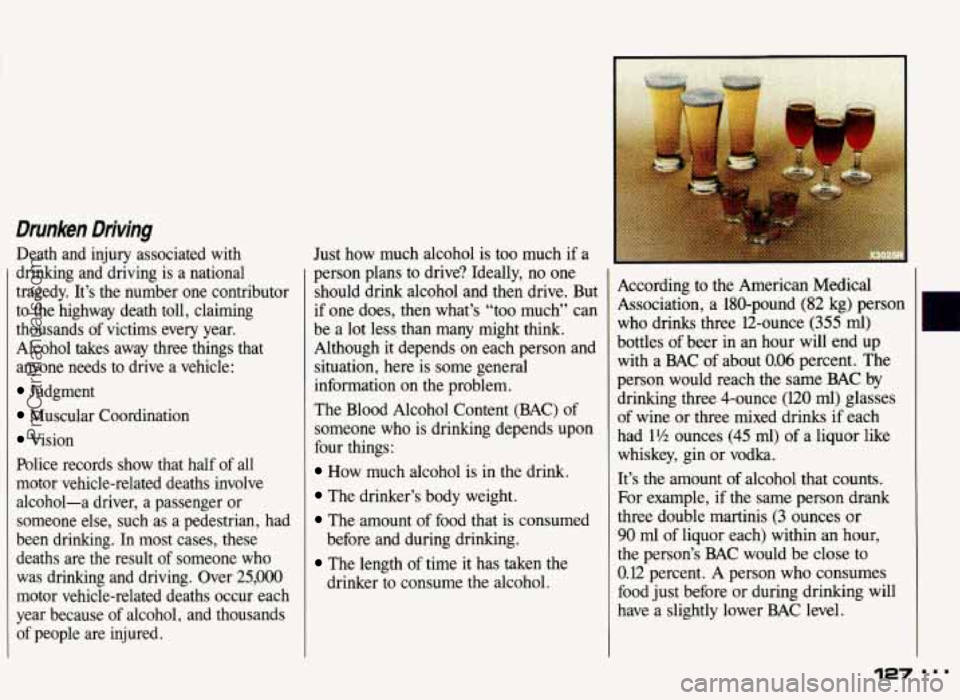
Drunken Driving
Death and injury associated with
drinking and driving is a national
tragedy. It's the number one contributor
to the highway death toll, claiming
thousands
of victims every year.
Alcohol takes away three things that
anyone
needs to drive a vehicle:
Judgment
Muscular Coordination
Vision
Police records show that half
of all
motor vehicle-related deaths involve alcohol-a driver,
a passenger or
someone else, such as a pedestrian, had
been drinking. In most cases, these deaths are the result
of someone who
was drinking and driving. Over 25,000
motor vehicle-related deaths occur each
year because
of alcohol, and thousands
of people are injured. person plans
to drive? Ideally, no one
should drink alcohol and then drive. But
if one does, then what's
"too much" can
be
a lot less than many might think.
Although it depends on each person and
situation, here is some general
information
on the problem.
The Blood Alcohol Content (BAC) of
someone who
is drinking depends upon
four things:
How much alcohol is in the drink.
The drinker's body weight.
The amount of food that is consumed
before and during drinking.
The length of time it has taken the
drinker to consume the alcohol. According to the American
Medical
Association,
a 1SO-pund (82 kg) person
who drinks three 12-ounce (355 ml)
bottles of beer in an hour will end up
with
a BAC of about 0.06 percent. The
person would reach the same BAC
by
drinking three 4-ounce (120 ml) glasses
of wine or three mixed
drinks if each
had 1% ounces (45 ml) of a liquor like
whiskey, gin or
vodka.
It's the amount of alcohol that counts.
For example, if the same person drank
three double martinis
(3 ounces or
90 ml of liquor each) within an hour,
the person's BAC would be close to
0.12 percent. A person who consumes
food
just before or during drinking will
have a slightly lower BAC level.
127
ProCarManuals.com
Page 131 of 306
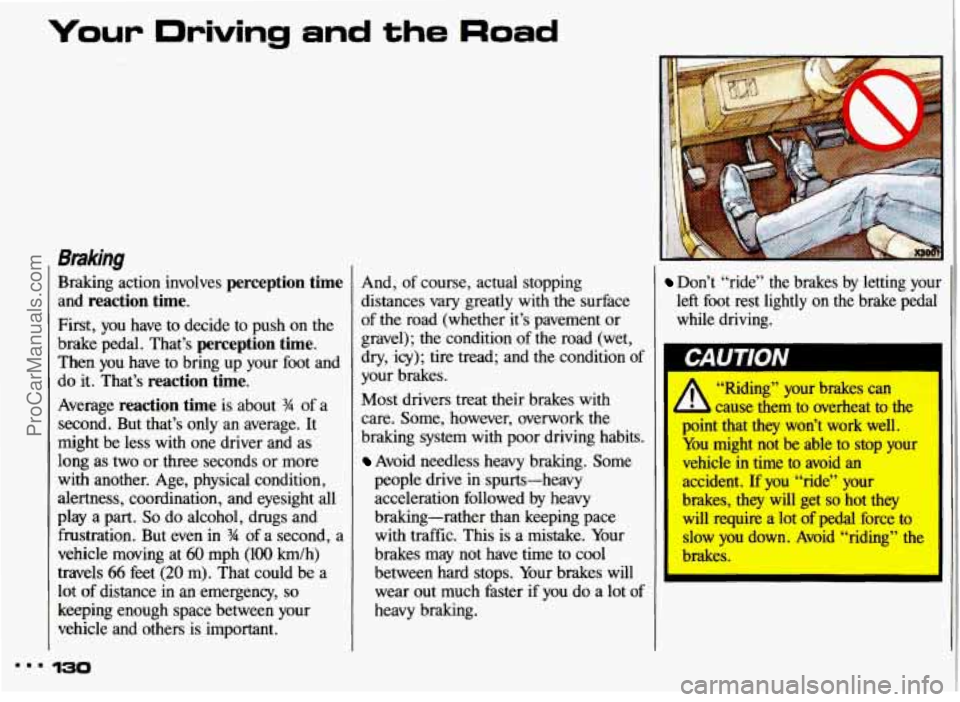
Your Driving and the Road
8mMng
Braking action involves perception time
and reaction time.
First, you have to decide to push on the
brake pedal. That’s perception time.
Then you have to bring up your foot and
do it. That’s reaction time.
Average reaction time is about 34 of a
second. But that’s only
an average. It
might be less with one driver and as
long as two or
three seconds or more
with another. Age, physical condition,
alertness, coordination,
and eyesight all
play a
part. So do alcohol, drugs and
frustration. But even in
34 of a second, a
vehicle moving at
60 mph (100 km/h)
travels
66 feet (20 m). That could be a
lot of distance in
an emergency, so
keeping enough space between your
vehicle and others is important. And,
of course, actual stopping
distances vary greatly with the surface
of the road (whether it’s pavement or
gravel); the condition of the road (wet,
dry, icy); tire tread; and the condition of
your brakes.
Most drivers treat their brakes with
care. Some, however, overwork the
braking system with poor driving habits.
Avoid needless heavy braking. Some
people drive in spurts-heavy
acceleration followed by heavy
braking-rather than keeping
pace
with traffic. This is a mistake. Your
brakes may not have time to cool
between hard stops. Your brakes will
wear out much faster if you
do a lot of
heavy braking.
Don’t “ride” the brakes by letting your
left foot rest lightly on the brake
pedal
while driving.
“Riding” your brakes can
cause them to overheat to the
point that they won’t work well.
You might not be able to stop your
vehicle in time to avoid an
accident.
If you “ride” your
brakes, they will get
so hot they
will require a lot of pedal force to slow you down. Avoid “riding” the
I
I brakes.
m.. 130
ProCarManuals.com
Page 132 of 306
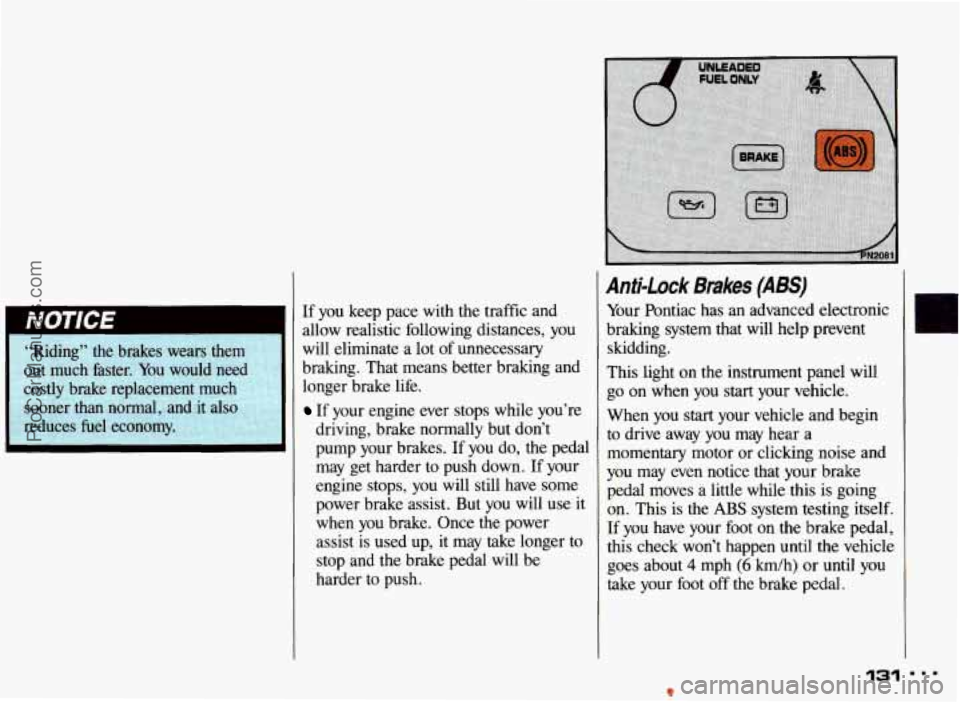
“Riding” the brakes wears them
out much faster. You would need
costly brake replacement
much
sooner than normal, and it also reduces fuel economy. If you keep pace with the traffic and
allow realistic following distances,
you
will eliminate a lot of unnecessary
braking. That means better braking and
longer brake life. If your engine ever stops while you’re
driving, brake normally but don’t
pump your brakes. If you do, the pedal
may get harder to push down. If your
engine stops, you will still have some
power brake assist. But
you will use it
when you brake. Once the power
assist is used up, it may take longer
to
stop and the brake pedal will be
harder to push.
Anti-Lock Bmkes (ABS)
Your Pontiac has an advanced electronic
braking system that will help prevent
skidding.
This light on the instrument panel will
go on when you start your vehicle.
When you
start your vehicle and begin
to drive away you may hear a
momentary motor or clicking noise
and
you may even notice that your brake
pedal moves a little while this is going
on. This is the ABS system testing itself.
If you have your foot on the brake
pedal,
this check won’t happen until the vehicle
goes about
4 mph (6 km/h) or until you
take your foot off the brake pedal.
131
ProCarManuals.com
Page 133 of 306
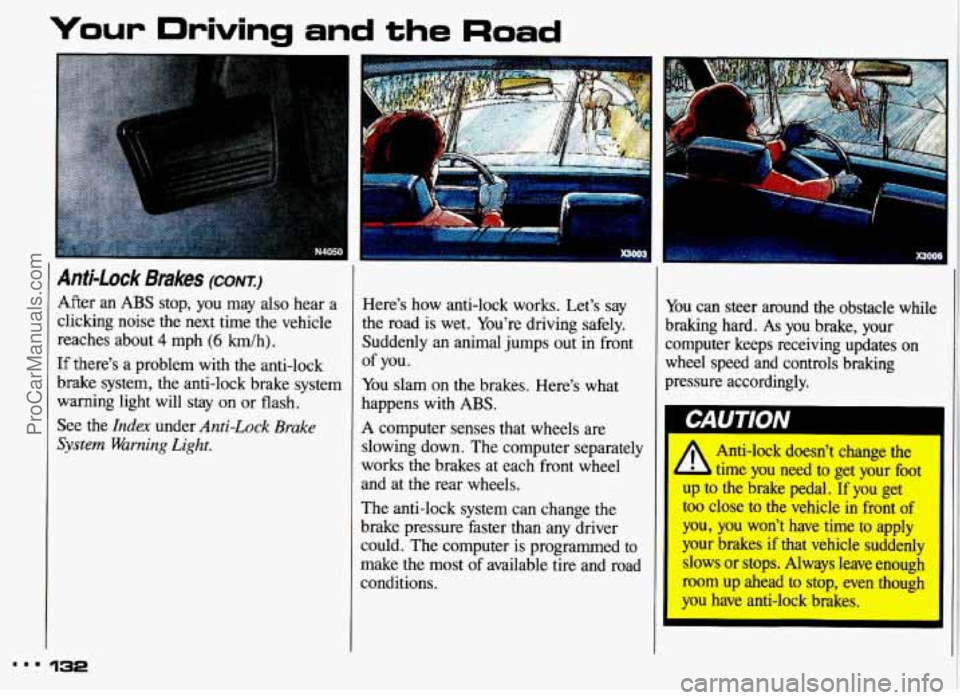
...
Your Driving and the Road
Anti-Lock Brakes (CONT.)
After an ABS stop, you may also hear a
clicking noise the next time the vehicle
reaches about
4 mph (6 km/h).
If there’s a problem with the anti-lock
brake system, the anti-lock brake system
warning light will stay
on or flash.
See the
Index under Anti-Lock Brake
System Warning Light.
132
Here’s how anti-lock works. Let’s say
the road is wet. You’re driving safely.
Suddenly an animal jumps out in front
You slam on the brakes. Here’s what
happens with ABS.
A computer senses that wheels are
slowing down. The computer separately
works the brakes at each front wheel
and at the rear wheels.
The anti-lock system can change the
of you.
brake pressure faster than any driver
could. The computer
is programmed to
make the most
of available tire and road
conditions. You
can steer around the obstacle while
braking hard.
As you brake, your
computer keeps receiving updates on
wheel speed and controls braking
pressure accordingly.
Anti-lock doesn’t change the
time you need
to get your foot
the brake pedal. If you get
too close to the vehicle in front
of
I you, you won’t have time to apply
your brakes
if that vehicle suddenly
slows or stops. Always leave enough
room up ahead to stop, even though
you have anti-lock brakes.
ProCarManuals.com
Page 135 of 306
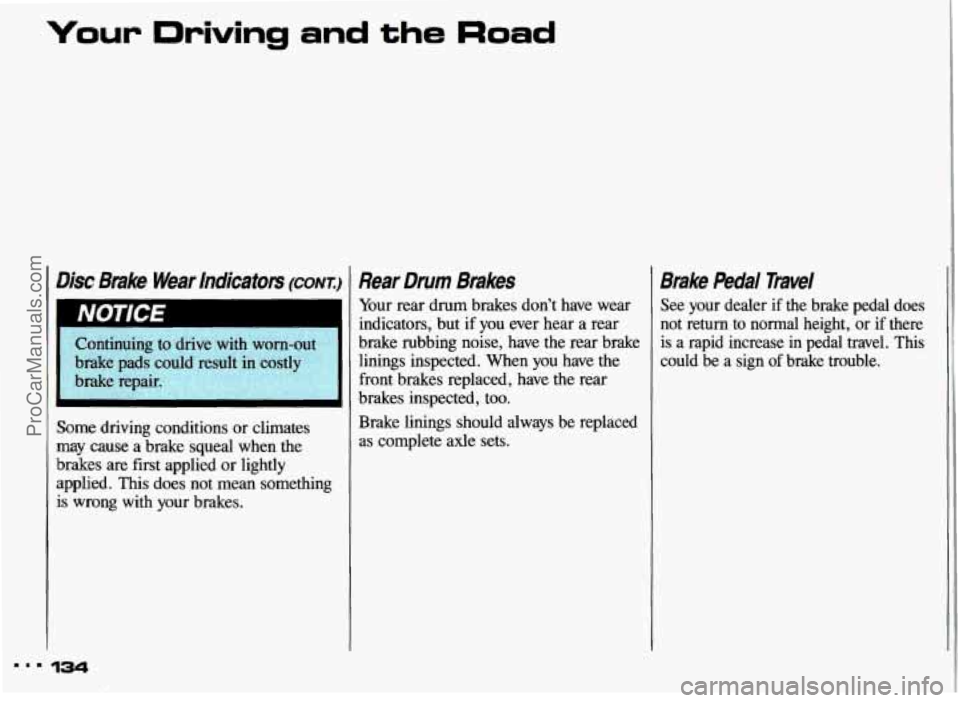
'Your Driving and the Road
Disc Brake Wear Indicators (CONTJ
I
Continuing to drive with worn-out
brake pads could res
: brake repair. P". I
Some driving conditions or climates
may cause a brake squeal when the
brakes are fmt applied or lightly
applied. This does not mean something
is wrong with your brakes.
Rear Drum Brakes
Your rear drum brakes don't have wear
indicators, but if you ever hear a rear
brake rubbing noise, have the rear brake
linings inspected. When you have the
front brakes replaced, have the rear
brakes inspected, too.
Brake linings should always be replaced
as complete axle sets.
Brake Pedal Travel
See your dealer if the brake pedal does
not return to normal height, or if there
is a rapid increase in pedal travel. This
could be
a sign of brake trouble.
ProCarManuals.com
Page 137 of 306
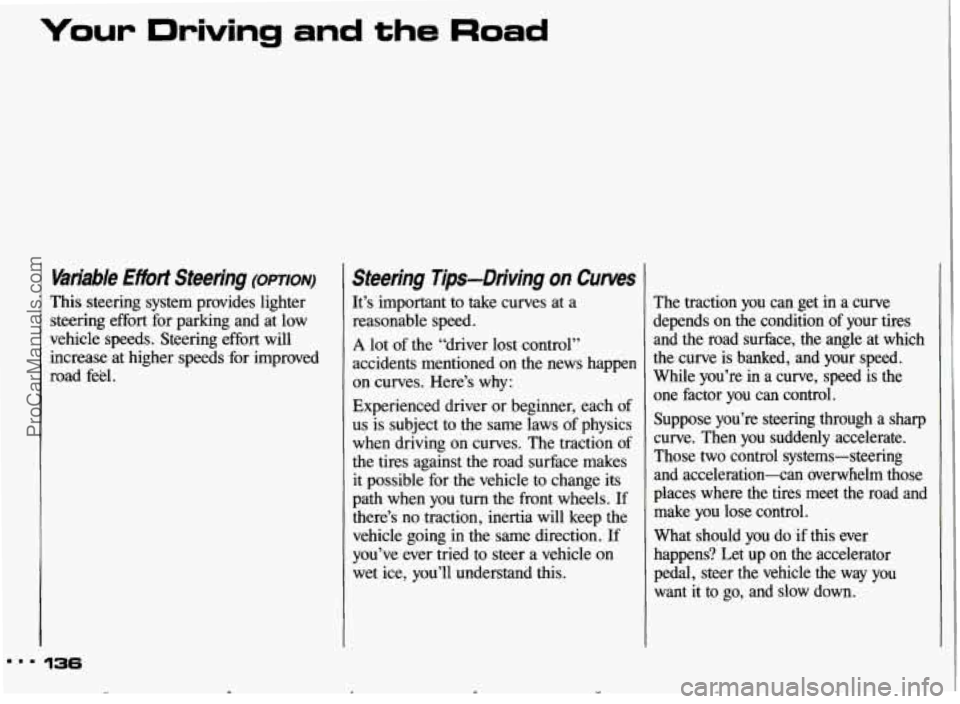
Your Driving and the Road
Variable Effort Steering (omoN)
This steering system provides lighter
steering effort for parking and at low
vehicle speeds. Steering effort will
increase at higher
speeds for improved
road feel.
Steering Tips-Driving on Curves
It’s important to take curves at a
reasonable speed.
A lot of the “driver lost control”
accidents mentioned on the
news happen
on curves. Here’s why:
Experienced driver or beginner, each
of
us is subject to the same laws of physics
when driving on curves. The traction of
the tires against the road surface makes
it possible for the vehicle to change its
path when you
turn the front wheels. If
there’s no traction, inertia will keep the
vehicle going in the same direction. If
you’ve ever tried to steer a vehicle on
wet ice, you’ll understand this. The traction
you
can get in a curve
depends on the condition of your tires
and the road surface, the angle at which
the curve is banked, and your speed.
While you’re
in a curve, speed is the
one factor you can control.
Suppose you’re steering through
a sharp
curve. Then you suddenly accelerate. Those
two control systems-steering
and acceleration-can overwhelm those
places where the tires meet the road and make you lose control.
What should you do if this ever
happens? Let up on the accelerator
pedal, steer the vehicle the way you
want it to go, and slow down.
8.8 136
ProCarManuals.com
Page 138 of 306
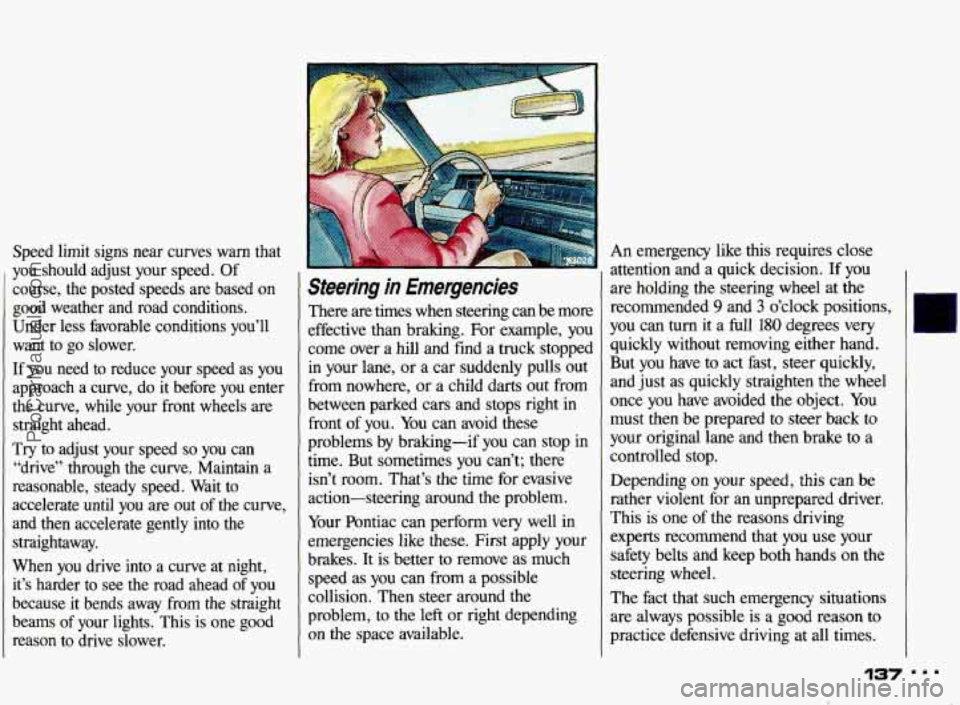
Speed limit signs near curves warn that
you should adjust your speed. Of
course, the posted speeds are based
on
good weather and road conditions.
Under less favorable conditions you’ll
want to go slower.
If you need to reduce your speed as you
approach a curve, do it before you enter
the curve, while your front wheels are
straight ahead.
Try to adjust your speed
so you can
“drive” through the curve. Maintain a
reasonable, steady speed. Wait to
accelerate until
you are out of the curve,
and then accelerate gently into the
straightaway.
When
you drive into a curve at night,
it’s harder to see the road ahead of you
because it bends away from the straight
beams of your lights. This is one good
reason to drive slower.
Steering in Emergencies
There are times when steering can be more
effective than braking. For example, you
come over a hill and find a truck stopped
in your lane, or a car suddenly pulls out
from nowhere, or a child darts out from
between parked cars and stops right in
front of you.
You can avoid these
problems by braking-if
you can stop in
time. But sometimes you can’t; there
isn’t
room. That’s the time for evasive
action-steering around the problem.
Your Pontiac can perform very well in
emergencies like these. First apply your
brakes. It is better to remove as much
speed as you can from a possible
collision. Then steer around the
problem, to the left or right depending
on the space available. An emergency like this requires
close
attention and
a quick decision. If you
are holding the steering wheel at the
recommended
9 and 3 o’clock positions,
you can turn it a
full 180 degrees very
quickly without removing either hand.
But
you have to act fast, steer quickly,
and just as quickly straighten the wheel
once
you have avoided the object. You
must then be prepared to steer back to
your original lane and then brake to a
controlled stop.
Depending on your speed, this can
be
rather violent for an unprepared driver.
This is one of the reasons driving
experts recommend that
you use your
safety belts and keep both hands on the
steering wheel.
The fact that such emergency situations
are always possible is a good reason to
practice defensive driving at all times.
ProCarManuals.com
Page 139 of 306

Your Driving and the Road
Off-Road Recovery
You may find sometime that your right
wheels have dropped off the edge of a
road onto the shoulder while you're
driving.
If the level of the shoulder is only
slightly below the pavement, recovery
should be fairly easy. Ease off the
accelerator and then, if there is nothing
in the way, steer
so that your vehicle
straddles the edge of the pavement. You
can turn the steering wheel up
to 94 turn
until the right front tire contacts the
pavement edge. Then turn your steering
wheel to go straight down the roadway.
If the shoulder appears
to be about four
inches
(100 mm) or more below the
pavement, this difference can cause
problems.
If there is not enough room to pull
entirely onto the shoulder and stop,
then follow the same procedures. But
if
the right front tire scrubs against the
side of the pavement, do
not steer more
sharply. With too much steering angle,
the vehicle may jump back onto the road
with
so much steering input that it
crosses over into the oncoming traffic
before you can bring
it back under
control. Instead, ease off again on the
accelerator and steering input, straddle
the pavement once more, then try again.
Passing
The driver of a vehicle about to pass
another on a two-lane highway waits for
just
the right moment, accelerates,
moves around the vehicle ahead, then
goes back into the right lane again.
A
simple maneuver?
Not necessarily! Passing another vehicle
on a two-lane highway
is a potentially
dangerous move, since the passing
vehicle occupies the same lane as oncoming traffic for several seconds.
A
miscalculation, an error in judgment, or
a brief surrender to frustration or anger
can suddenly put the passing driver face
to face with the worst of all traffic
accidents-the head-on collision.
I.. 138
ProCarManuals.com